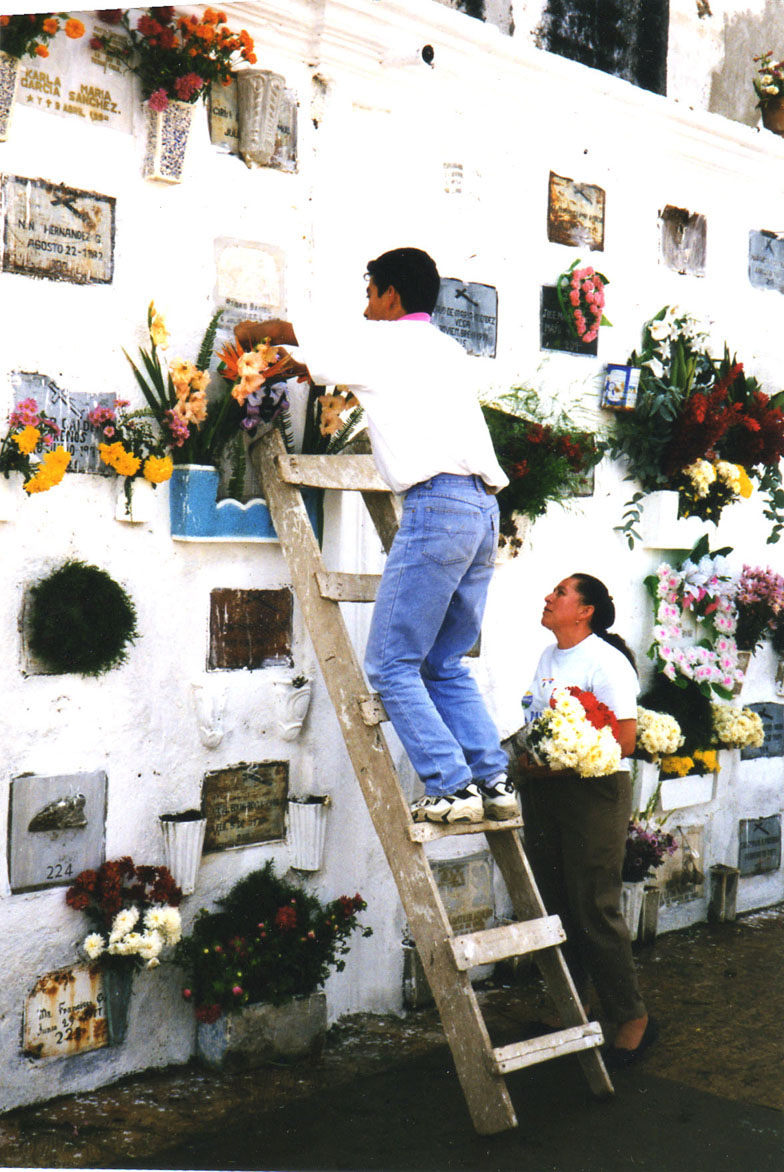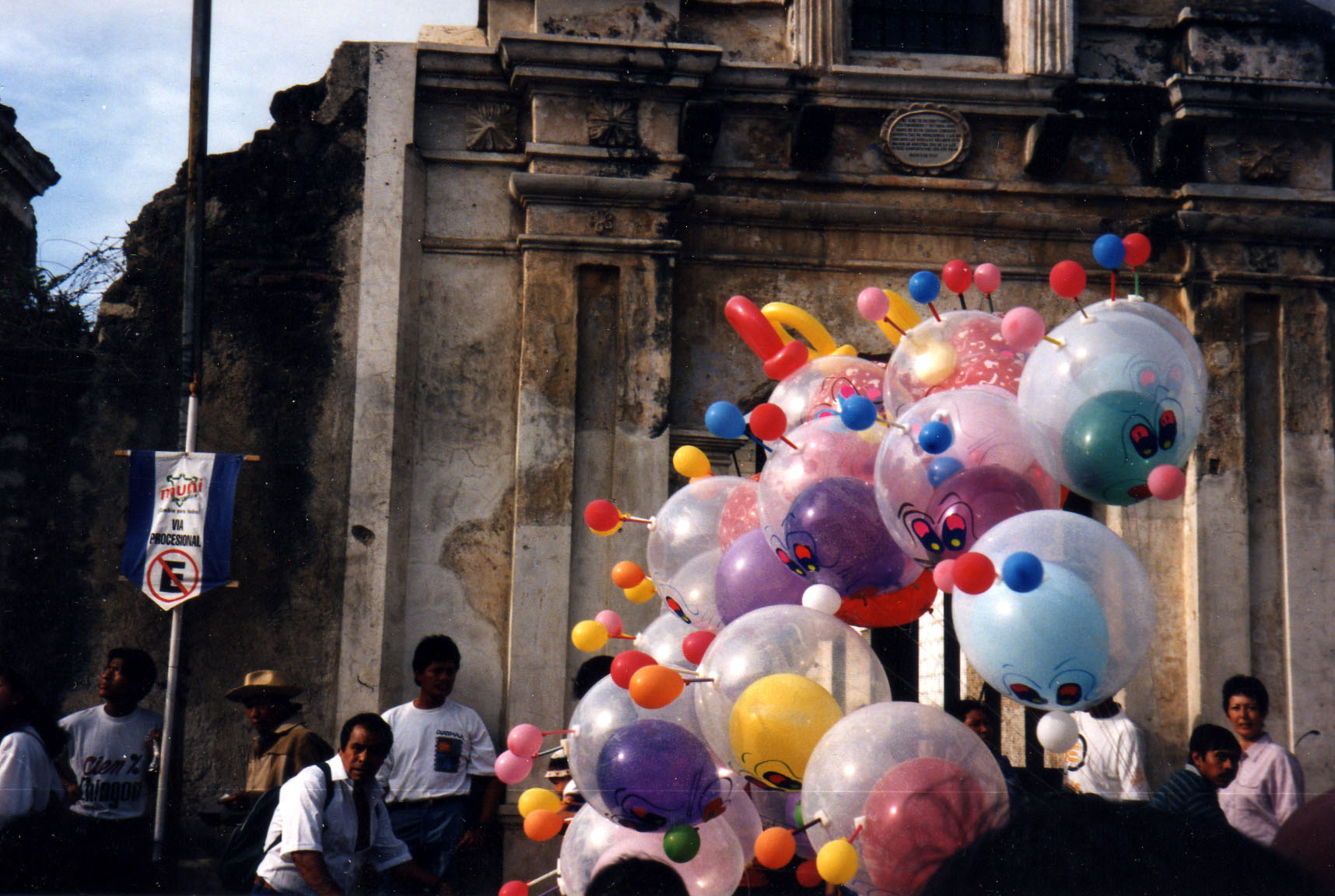by Katherine McIntyre
“Tomorrow is Todos Santos Day and everything is closed,” warned Maria, the desk clerk at my hotel, as she handed me the key to my room. “That’s when we go to the cemetery to visit our ancestors.”
This was a bit of an obstacle in my self-guided tour through Guatemala. With all museums closed, I did what everyone else in the historic city of Antigua was doing: I joined the endless stream of local people on their way to St. Lazaros Cemetery. They were going to picnic with the departed. Dressed in their best clothes, they juggled picnic baskets, incense, cedar wreaths and elaborate floral arrangements of roses, carnations, birds of paradise and chrysanthemums, with slices of watermelon and oranges tucked in the mix.
 Todos Santos (All Saints’ Day) always falls on November 1, but preparations begin the day before.
Todos Santos (All Saints’ Day) always falls on November 1, but preparations begin the day before.
While North Americans are dressing up as goblins and ghosts for Halloween, Guatemalan families are freshening the pillars and cornices on their ancestral mausoleums. Armed with ladders, long-handled scrubbing brushes, and big pails of whitewash, they remove the grey streaks of mildew and the dried green slime left from the rainy season. They clip the grass around each plot and daub traces of rust on the wrought iron fences with black paint.
Within the whitewashed walls, the somber cemetery was transformed. The mausoleums gleamed against the azure sky. Flowers were everywhere. The air was fragrant with the tang of giant cedar and eucalyptus trees. Emerald hummingbirds sucked nectar from flaming hibiscus and a marimba band played melancholy music with a Latin beat. A volcano smoldered gently in the distance and the overall air was of sober festivity.
The Spanish, German, and English family names engraved in bold letters on the tombs reflect the history of Guatemala. The crumbling and forgotten plot of a German, Alfred von Neuminister Schwezer 1845-1876, provided one Guatemalan family with a practical place to picnic. The mother, an ample woman in a black and red print dress, spread out a white lace tablecloth on the top of the old stone tomb. From her large wicker basket came big bowls of fiambre, a traditional food for the day consisting of a mixture of beets, hard-boiled eggs, chicken, onions and carrots.
Picnic over and farewells made, I was off by a decrepit local bus to the nearby village of Acatenango for a celebration of a different kind. The bus wound its way through lush and orderly plantations where some of the world’s best coffee is grown. The bright-red berries on the coffee bushes were ready for harvesting, but no one was picking that day. The villagers were at their local cemetery laying neon-bright plastic wreaths, big crosses of marigolds and bright paper streamers in Mayan colors of green and blue on their ancestors’ graves. They picnicked, talked to their ancestors and, to ensure prosperity in the coming year, provided them with plenty of food and drink.
Once the formalities were completed, everyone converged on the village square for a full-blown Latin fiesta. Jangling ice cream vendors competed with the hot staccato beat of ear-piercing music thundering from amplifiers fastened to the roof of a broken-down car. Women from the local parishes, shaded by tattered canopies in makeshift stalls, dished out the traditional Todos Santos foods from big enamel pots.
“Siete, siete.” A Mayan family invited me to sit with them at a rickety table. The mother was dressed in a traditional bright, flowered huipil and a navy skirt. Her thick black hair hung in a long braid down her back. Her sons were in t-shirts with American logos, her daughters in traditional dress. Defying the guidebook warning “not to eat in a market place,” I sampled the tantalizing specials: hot tamales wrapped in cornhusks, fiambre, and barbecued chicken washed down with the local beer.
“Dama, esta deliciosa.” I nearly lost a tooth when I bit into a slab of pumpkin candy—a confection of caramelized pumpkin, brown sugar, cinnamon and ginger, another specialty of the celebration whose significance has been lost in history.
Giant kites, some up to two meters in diameter, floated overhead. Attached to their long tails were messages to the departed to let them know about family affairs and to ask God for special favors, maybe a new car, a job, a good harvest or a wife.
The music grew louder, the beer flowed, and bottles came out of hip pockets. The fiesta was heating up; it was time for me to return to Antigua through the tranquil coffee fields, just as the sun was setting behind the misty volcano. Todos Santos was nearly over, and tomorrow it would be back to business, Latin style!
For more information about traveling to Guatemala, visit:
http://www.visitguatemala.com/
http://www.guatemalatravel.com/
www.antiguaguatemala.com/
-----
To buy this article for use in your publication, click here.